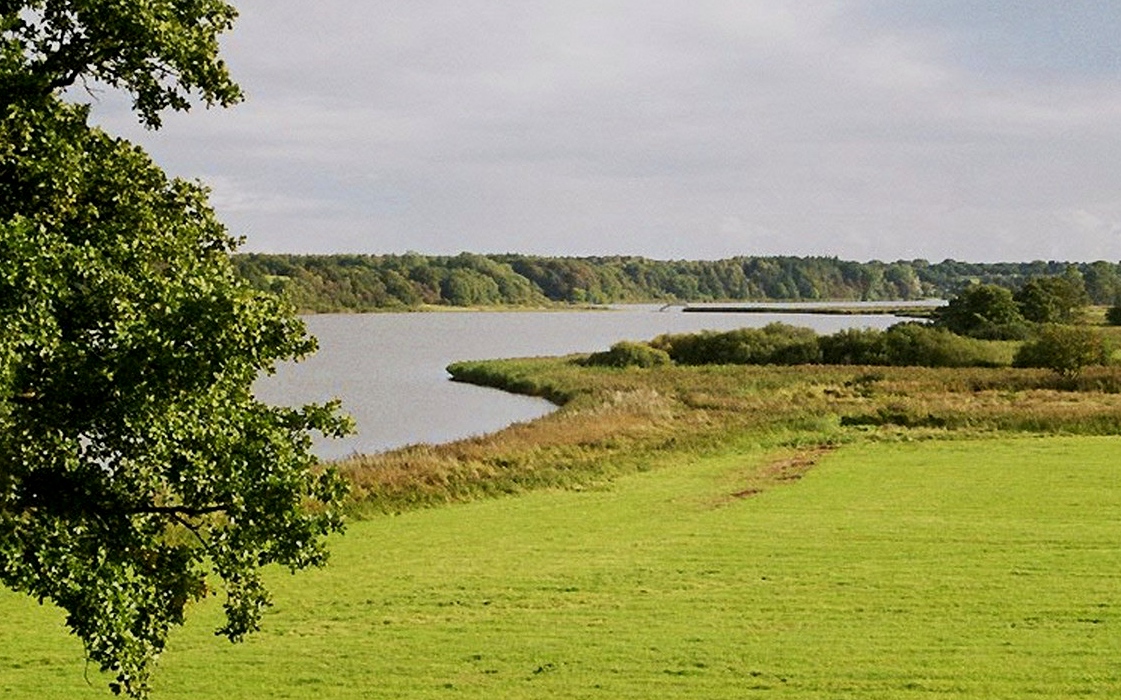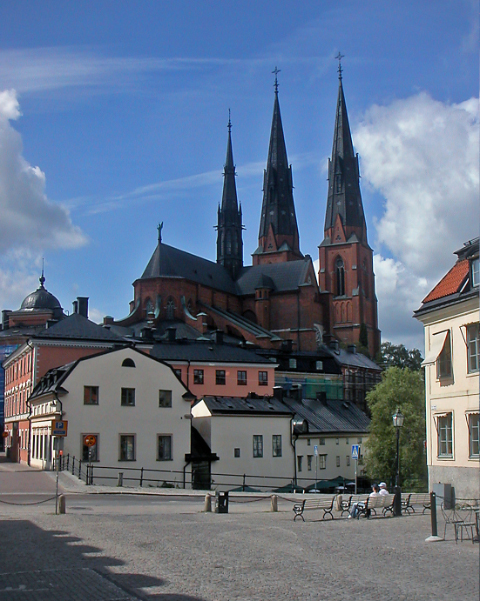|
Uppland Rune Inscription 1011
This runestone, listed in Rundata as runic inscription U 1011, was carved in the 11th century and was originally located at Örby, Rasbo, Sweden. Description This runestone consists of a runic inscription on two sides with the text within a serpent and a cross at the top. The runestone was moved from Rasbo to Uppsala in the 17th century. In 1867 this runestone, along with U 489 and U 896, was exhibited in the Exposition Universelle in Paris. It was dropped in Le Havre during its return. After having lain there for several decades, it was returned to Uppsala. It now stands in the ''Universitetsparken'' (the University Park) close to the main building of Uppsala University. This is an unusual runestone in that its sponsor, Vigmund, raised it in honor of himself. There are over twenty other runestones where the sponsor stated that the stone was raised in memory of himself, including Sö 55 in Bjudby, U 127 in Danderyds, the now-lost U 149 in Hagby, U 164 and U 165 in Täby, ... [...More Info...] [...Related Items...] OR: [Wikipedia] [Google] [Baidu] |
Runestone U 1011 Left
A runestone is typically a raised stone with a runic inscription, but the term can also be applied to inscriptions on boulders and on bedrock. The tradition began in the 4th century and lasted into the 12th century, but most of the runestones date from the late Viking Age. Most runestones are located in Scandinavia, but there are also scattered runestones in locations that were visited by Norsemen during the Viking Age. Runestones are often memorials to dead men. Runestones were usually brightly coloured when erected, though this is no longer evident as the colour has worn off. The vast majority of runestones are found in Sweden. History The tradition of raising stones that had runic inscriptions first appeared in the 4th and 5th century, in Norway and Sweden, and these early runestones were usually placed next to graves. The earliest Danish runestones appeared in the 8th and 9th centuries, and there are about 50 runestones from the Migration Period in Scandinavia. Most runeston ... [...More Info...] [...Related Items...] OR: [Wikipedia] [Google] [Baidu] |
Jarlabanke Runestones
The Jarlabanke Runestones ( sv, Jarlabankestenarna) is the name of about 20 runestones written in Old Norse with the Younger Futhark rune script in the 11th century, in Uppland, Sweden. They were ordered by what appears to have been a chieftain named Jarlabanke Ingefastsson and his clan (Swedish: ''Jarlabankeätten''), in Täby.Hadenius, Nilsson & Åselius 53. Jarlabanke was probably a hersir (chieftain of a hundred) responsible for the local leidang organization and on several runestones he stated that he was a Christian and not a Pagan. Omeljan Pritsak has remarked that Jarlabanke's prominent position and property show that he and his clan profited from taking part in the Danegelds and from the services that men of his clan provided as mercenaries in the Varangian Guard and in Kievan Rus'.Pritsak 1981:389 Inscription Five of the runestones contain very much the same message: "Jarlabanke had these stones made after himself while he was alive. He made this bridge for his soul ... [...More Info...] [...Related Items...] OR: [Wikipedia] [Google] [Baidu] |
Runic Alphabet
Runes are the letters in a set of related alphabets known as runic alphabets native to the Germanic peoples. Runes were used to write various Germanic languages (with some exceptions) before they adopted the Latin alphabet, and for specialised purposes thereafter. In addition to representing a sound value (a phoneme), runes can be used to represent the concepts after which they are named (ideographs). Scholars refer to instances of the latter as ('concept runes'). The Scandinavian variants are also known as ''futhark'' or ''fuþark'' (derived from their first six letters of the script: '' F'', '' U'', '' Þ'', '' A'', '' R'', and '' K''); the Anglo-Saxon variant is ''futhorc'' or ' (due to sound-changes undergone in Old English by the names of those six letters). Runology is the academic study of the runic alphabets, runic inscriptions, runestones, and their history. Runology forms a specialised branch of Germanic philology. The earliest secure runic inscriptions date from aro ... [...More Info...] [...Related Items...] OR: [Wikipedia] [Google] [Baidu] |
Hedeby
Hedeby (, Old Norse ''Heiðabýr'', German language, German ''Haithabu'') was an important Danes, Danish Viking Age (8th to the 11th centuries) trading settlement near the southern end of the Jutland Peninsula, now in the Schleswig-Flensburg district of Schleswig-Holstein, Germany. It is the most important archaeological site in Schleswig-Holstein. Around 965, chronicler Ibrahim ibn Yaqub, Abraham ben Jacob visited Hedeby and described it as, "a very large city at the very end of the world's ocean." The settlement developed as a trading centre at the head of a narrow, navigable inlet known as the Schlei, which connects to the Baltic Sea. The location was favorable because there is a short portage of less than 15 km to the Treene River, which flows into the Eider River, Eider with its North Sea estuary, making it a convenient place where goods and ships could be pulled on a corduroy road overland for an almost uninterrupted seaway between the Baltic and the North Sea and avoid ... [...More Info...] [...Related Items...] OR: [Wikipedia] [Google] [Baidu] |
Stone Of Eric
The Stone of Eric, listed as DR 1 in the Rundata catalog, is a memorial runestone that was found in Northern Germany. This area was part of Denmark during the Viking Age. Description The Stone of Eric is one of the Hedeby stones. It was found in 1796 at Danevirke and moved to a park in Schleswig. Like the Skarthi Rune stone, DR 3, it is believed to have been raised in about 995 C.E. Its inscription describes an attack from the Swedish king Eric the Victorious on Hedeby, who took advantage of the fact that Sweyn Forkbeard was campaigning in England. The inscription refers to King Sweyn's ''hemþægi'' or ''heimþegi'' (pl. ''heimþegar''), meaning "home-receiver" (i.e., one who is given a house by another). A total of six runestones in Denmark refer to a person with this title, the others being DR 3 in Haddeby, the now-lost DR 154 in Torup, DR 155 in Sjørind, and DR 296 and DR 297 in Hällestad. The use of the term in the inscriptions suggest a strong similarity between ''h ... [...More Info...] [...Related Items...] OR: [Wikipedia] [Google] [Baidu] |
Uppsala Cathedral
Uppsala Cathedral ( sv, Uppsala domkyrka) is a cathedral located between the University Hall of Uppsala University and the Fyris river in the centre of Uppsala, Sweden. A church of the Church of Sweden, the national church, in the Lutheran tradition, Uppsala Cathedral is the seat of the Archbishop of Uppsala, the primate of Sweden. It is also the burial site of King Eric IX (c. 1120–1160, reigned 1156–1160), who became the patron saint of the nation, and it was the traditional location for the coronation of new Kings of Sweden. The current archbishop is Martin Modéus and the current bishop is Karin Johannesson. The cathedral dates to the late 13th century and, at a height of , it is the tallest church in the Nordic countries. Originally built under Roman Catholicism, it was used for coronations of Swedish monarchs for a lengthy period following the Protestant Reformation. Several of its chapels were converted to house the tombs of Swedish monarchs, including Gustav Vas ... [...More Info...] [...Related Items...] OR: [Wikipedia] [Google] [Baidu] |
Uppland Runic Inscription Fv1976;104
This runic inscription, designated as U Fv1976;104 in the Rundata catalog, is on a Viking Age memorial runestone that is located at the Uppsala Cathedral, Uppland, Sweden. Description This inscription consists of runic text in the younger futhark that is carved on an intertwined serpent under a small Christian cross. The red granite runestone, which is 1.65 meters in height and 1.64 meters wide, was discovered in May 1975 during excavation work at the Hornska chapel at the Uppsala Cathedral. pp. 104-106. Before the historical nature of runestones was understood, they were often reused as materials in the construction of roads, bridges, and buildings. The runestone is classified as being carved in runestone style Pr2, which is also known as Ringerike style. This is the classification for inscriptions where the runic bands end in serpent or beast heads seen in profile, but the serpents or beasts are not as elongated and stylized as in the Urnes style. The runic text states that thr ... [...More Info...] [...Related Items...] OR: [Wikipedia] [Google] [Baidu] |
Fjuckby
Fjuckby () is a village in Uppsala Municipality, Uppsala County, Sweden, located about 15 km (9.3 km) north of the central city Uppsala along European route E4. The village has a population of 65 people (as of 2000) within an area of 18 hectares (44.5 acres). Known as a site for runestones, the village's name has generated worldwide interest in the village. History Prior to the 1930s, the village was known as Fjukeby.O'Mahony, Paul. (December 14, 2006) The Local. Residents of Fjuckby demand new name.' In the 1930s, the spelling of the name of this small village was changed to Fjuckby. With the rise of international travel by Anglophones, and the rise of global communications, English speaking tourists have traveled to Fjuckby out of amusement at the name in order to ridicule it.Olbermann, Keith. (December 14, 2006) NBC News News. 'Countdown with Keith Olbermann' for Dec. 14.' Part 1. (reporting, " But now, here are COUNTDOWN‘s top three newsmakers of this day. ... ... [...More Info...] [...Related Items...] OR: [Wikipedia] [Google] [Baidu] |
Urnes Style
Viking art, also known commonly as Norse art, is a term widely accepted for the art of Scandinavian Norsemen and Viking settlements further afield—particularly in the British Isles and Iceland—during the Viking Age of the 8th-11th centuries. Viking art has many design elements in common with Celtic, Germanic, the later Romanesque and Eastern European art, sharing many influences with each of these traditions. Generally speaking, the current knowledge of Viking art relies heavily upon more durable objects of metal and stone; wood, bone, ivory and textiles are more rarely preserved. The artistic record, therefore, as it has survived to the present day, remains significantly incomplete. Ongoing archaeological excavation and opportunistic finds, of course, may improve this situation in the future, as indeed they have in the recent past. Viking art is usually divided into a sequence of roughly chronological styles, although outside Scandinavia itself local influences are ofte ... [...More Info...] [...Related Items...] OR: [Wikipedia] [Google] [Baidu] |
Runestone Style
:''The term "runestone style" in the singular may refer to the Urnes style.'' The style or design of runestones varied during the Viking Age. The early runestones were simple in design, but towards the end of the runestone era they became increasingly complex and made by travelling runemasters such as Öpir and Visäte. A categorization of the styles was developed by Anne-Sophie Gräslund in the 1990s. Her systematization is considered to have been a break-through and is today a standard. The styles are RAK, Fp, Pr1, Pr2, Pr3, Pr4 and Pr5, and they cover the period 980-1130, which was the period during which most runestones were made. The styles Pr1 and Pr2 correspond to the Ringerike style, whereas Pr3, Pr4 and Pr5 belong to what is more widely known as the Urnes style.Sawyer 2000:32 Below follows a brief presentation of the various styles by showing sample runestones according to Rundata's annotation. RAK RAK is the oldest style and covers the period 980-1015 AD, but the Ru ... [...More Info...] [...Related Items...] OR: [Wikipedia] [Google] [Baidu] |






